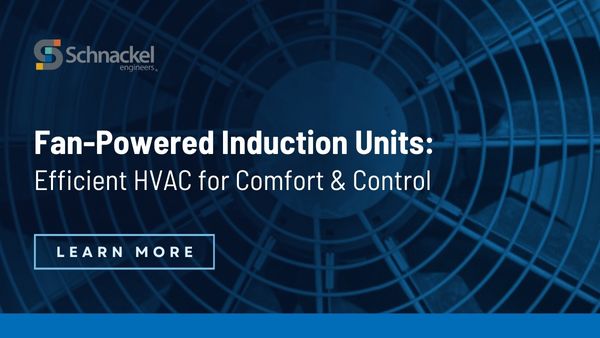Fan-Powered Induction Units: Efficient HVAC for Comfort & Control

In the ever-evolving landscape of HVAC systems, one innovation has been quietly revolutionizing the way we think about indoor climate control. Fan-Powered Induction Units (FPIUs) have emerged as a game-changer, offering a unique blend of efficiency, comfort, and sustainability. This blog will serve as your guide to understanding the remarkable capabilities of FPIUs, exploring how they work, their benefits, and discovering the common applications where they shine. By the end, you’ll have the knowledge to discern if FPIUs are the appropriate HVAC solution for your building’s unique requirements.
What Are Fan-Powered Induction Units?
Fan-Powered Induction Units, commonly referred to as FPIUs, are innovative HVAC (Heating, Ventilation, and Air Conditioning) systems that have gained recognition for their exceptional efficiency and low physical profile. These units are engineered to precisely control and condition air for heating and cooling within indoor spaces. These types of units are also known as Sensible Cooling Terminal Units or DOAS Fan-Powered Terminal Units. The common thread is the use of conditioned primary outdoor air in parallel with a sensible only cooling coil utilizing a higher than standard chilled water supply temperature. For the purpose of this blog, we will refer to them collectively as FPIUs.
The key to their efficiency lies in their large multi-row cooling coils, which allow for warmer water to be used to cool the space. FPIUs are celebrated for their ability to deliver individualized comfort while conserving energy, making them a popular choice for a variety of HVAC design applications.
How Does a Fan-Powered Induction Unit Work?
FPIUs draw in air from the surrounding environment, combining room air (induced air) with the outside air (primary air). If there is a call for cooling, only the room air is cooled using a chilled water cooling coil operating at a higher temperature (sensible cooling only) than would be used in a traditional fan coil unit. The primary air is preconditioned and dehumidified at the DOAS unit, and then delivered to the FPIU as cool, dry air. If there is a call for heating the FPIU cooling coil is off and the combined air is heated using hot water or electric heating coils. Once properly conditioned, the air is gently diffused into the indoor space.
FPIUs use efficient variable speed motors which provide separate control for outdoor air and recirculated room air. The FPIU can reduce the fan speed to save energy, while still maintaining the outdoor air rate for enhanced Indoor Air Quality (IAQ).
FPIUs are also known as “sensible-cooling terminal units” because they do not remove moisture from the air. This means they do not require sloped condensate piping, which can allow for higher ceilings. This also means humidity must be removed by a separate HVAC system, so choose your engineer wisely. FPIUs require a much more integrated approach between the operation of the central plant, outdoor air systems, and terminal units than is required with more conventional systems.
Benefits of Fan-Powered Induction Units
Energy Efficiency
Fan-Powered Induction Units allow for space cooling to be provided with warmer chilled water temperatures. Utilizing warmer chilled water reduces energy consumption, increases chiller capacity, and makes it easier to utilize “free cooling” on cool days. Their zoning capabilities and lower operating costs result in significant long-term savings for building owners.
Zoned Comfort
These units offer precise control over the indoor climate, allowing different zones within a building to be maintained at different temperatures. This zoning capability enhances occupant comfort and energy savings.
Reduced Ceiling Space
Fan-Powered Induction Units are designed with low clearance in mind. FPIUs have a low overall height and do not have condensate drains, eliminating sloped condensate piping, allowing for increased ceiling heights in tight floor-to-floor buildings or spaces.
Low Noise Levels
FPIUs are generally known for their quiet operation. They are smaller in zone size, do not contain any compressors, and can be designed with sound attenuators to create a peaceful indoor environment, making them ideal for applications such as offices, hotels, and healthcare facilities.
Easy Installation and Maintenance
Their compact design and ease of installation simplify the construction process. Additionally, Fan-Powered Induction Units typically have low maintenance requirements, reducing maintenance costs.
Improved Air Quality
These units promote better indoor air quality by constantly circulating and filtering the air room air. In addition, smaller zoned cooling systems like FPIUs limit the amount of recirculation between different spaces, reducing the chances of infectious aerosol spread between spaces. This is crucial for health-conscious building designs.
Applications of Fan-Powered Induction Units
FPIUs are commonly used in a variety of commercial and industrial applications, including:
- Offices
- Hotels
- Hospitals
- Schools
- Laboratories
- Retail stores
- Restaurants
Conclusion
Fan-Powered Induction Units stand as a testament to the continuous progress within the Architectural, Engineering, and Construction industry. Their demonstrated efficiency, enhanced comfort, and sustainable attributes make FPIUs an ideal choice for a variety of HVAC design applications. Because the overall efficiency of an FPIU system is strongly dependent on specifics of the chilled water plant operation, mechanical engineer selection is more critical than with many other system types.
If you’re eager to enhance your building projects with the capabilities of Fan-Powered Induction Units, we invite you to reach out to Schnackel Engineers. Our experienced team is ready to collaborate with you, bringing innovative technology and expertise to your next endeavor. Let us guide you in harnessing the potential of FPIUs for your upcoming projects. Your journey toward more efficient and sustainable designs begins here.
Comments